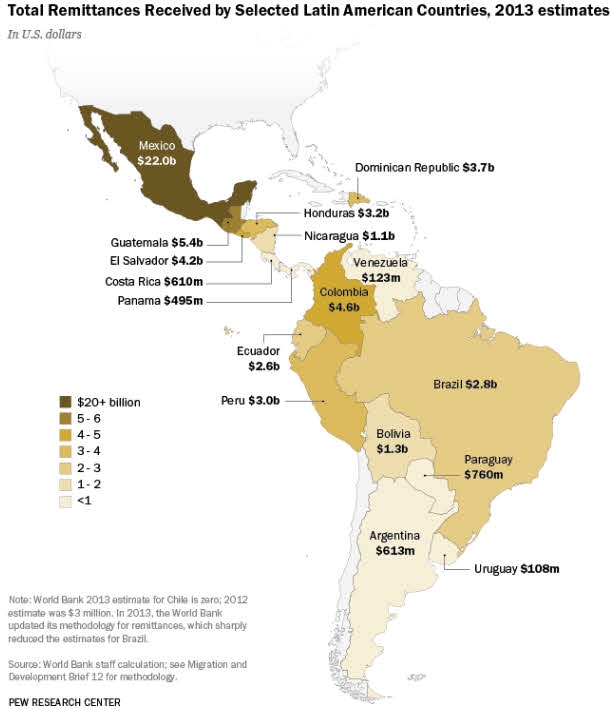
Migrants' remittances to Mexico, an estimated $22 billion in 2013, are 29% below their 2006 peak. For all other Spanish-speaking Latin American nations overall, the 2013 estimate of $31.8 billion slightly surpasses the 2008 peak.
Remittances from all sources to Spanish-speaking Latin American countries have more than doubled since 2000 but remain below their peak in 2007, the year in which the U.S. Great Recession began. The 2013 estimated total ($53.8 billion) is 13% below 2007's $61.6 billion (in 2013 U.S. dollars).
The United States is the most important source of money sent home by migrants to the 17 Latin American nations as a group (including Mexico). U.S. remittances accounted for three-quarters of the total in 2012—$41 billion out of $52.9 billion, according to World Bank data.
Mexico Falls, Latin America Overall Recovers
The decrease for Latin America overall was fueled by a falloff in remittances to Mexico, which receives more than 40% of all remittances to Latin America. If Mexico is excluded, remittance totals to Spanish-speaking Latin American countries as a whole have recovered after dropping during the U.S. recession years of 2007 to 2009.
Remittances to Mexico peaked in 2006. Aside from a single-year increase in 2011, they have fallen each year since then. Other countries in which 2013 estimated remittance flows have not recovered from declines during the U.S. recession years of 2007 to 2009 are Argentina, Colombia, Costa Rica, Dominican Republic and Ecuador.
However, in seven other Spanish-speaking Latin American countries, remittances either have rebounded from declines during the recession years of 2007 to 2009 or did not fall markedly during those years. In Bolivia, El Salvador, Guatemala and Honduras, remittances are estimated to be higher in 2013 than at their peak before the recession. In Nicaragua, Paraguay and Peru, remittances did not decline and have continued to rise.
The decline in remittances to Mexico—nearly all of which come from the U.S.—is linked to economic changes in the U.S., where one-in-ten Mexican-born people live. The U.S. housing market crash hurt Mexican immigrants for whom the construction industry is a major job source, although a World Bank analysis concludes that the housing market's link to remittance totals has weakened since 2011 (World Bank, 2013).
Another factor in the fall of remittances to Mexico could be the decline in the Mexican immigrant population in the U.S. since the onset of the recession, due to decreased arrivals and increased departures, including deportations. A Pew Research Center analysis of government data found that recent migration from the U.S. to Mexico equals and possibly exceeds migration from Mexico to the U.S. through at least 2012 (Passel, Cohn and Gonzalez-Barrera, 2012).
U.S. residents are the source of nearly all remittance money received in Mexico (98% in 2012) and of the majority of remittance money received in six other Spanish-speaking Latin American nations: Costa Rica, Dominican Republic, El Salvador, Guatemala, Honduras and Panama.
Remittances are a larger source of money to Latin America than official foreign aid. In 2011, when foreign aid to Spanish-speaking Latin America nations totaled $6.2 billion, formal remittances were more than eight times that—$53.1 billion.
A significant part of remittances, often the majority, is spent on food, clothing and other day-to-day needs, according to research. Although there is variation by country, a significant, but smaller, share goes to saving and investment. Households that receive remittances also are more likely than those that do not to spend money on health care and education (Ratha, 2013).
Who Sends Remittances Home?
Remittance totals are strongly linked to the size of a particular country's immigrant population in the U.S. and the share of its emigrants who live in the U.S. For example, the four Latin American nations that get the highest share of their remittances from the U.S.—Mexico, El Salvador, Guatemala and Honduras—also are the top four in terms of the share of their emigrants who live in the U.S. The Latin American nations with the lowest share of remittances from the U.S.—Uruguay, Bolivia and Paraguay—also have the lowest share of emigrants living in the U.S.
Most immigrants do send remittances home, and so do some people born in the U.S.; a Pew Research Center survey in 2008 found that 54% of foreign-born Hispanics and 17% of U.S.-born Hispanics say they
Source: Published originally on The Pew Research Hispanic Trends Project as Remittances to Latin America Recover—but Not to Mexico, November 15, 2013.
